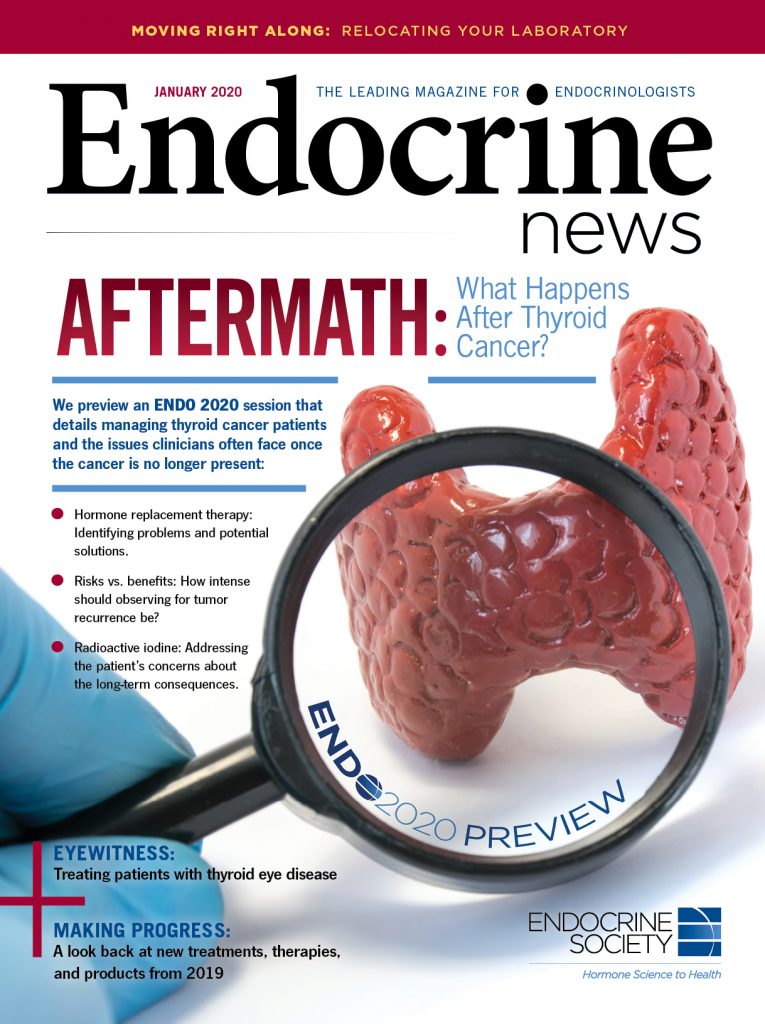
The challenges of managing thyroid cancer patients include regulating their hormone replacement therapy and monitoring for recurrence. Here, we highlight an upcoming ENDO 2020 session that details the issues in treating patients post-thyroid cancer therapy.
Thyroid cancer patients generally have an excellent prognosis but require careful management to optimize their care. Some strategies for optimizing this care based on the latest evidence will be covered in a session entitled “You’ve Been Cured of Thyroid Cancer — Now What?” at ENDO 2020 in March in San Francisco.
For many, if not most, patients, treatment involves a total thyroidectomy. Endocrinologists have a lot of experience with standard levothyroxine (T4) hormone replacement medication. Most patients do well with it, but “a subset do not feel good despite standard therapy. The question is, is it related to the management of their thyroid or not,” says Anne R. Cappola, MD, ScM, of the Perelman School of Medicine of the University of Pennsylvania in Philadelphia. She will speak at the session on dealing with the “unhappy thyroid patient.”
Steps to Better Management
Cappola follows several steps in treating these patients. “The first step is to try to optimize the management with levothyroxine. I begin by making sure they are taking their T4 appropriately and that their thyroid stimulating hormone (TSH) levels are in range. If you are not taking it right, and your levels are not right, then you are not going to feel right, and that is an easy thing to try to stabilize,” she says.
“The second step is to see what else is going on that can be causing those symptoms. If you sit down and talk to the patient, you may find another etiology,” she says. In one case, a patient changed jobs and reported feeling much better — leaving the stress of the previous job alleviated her symptoms. In another case, a patient had slight anemia and was receiving iron infusions. Her CBC results were off, and a hematologist spotted that her lymphocytes didn’t look right — and that led to a diagnosis of chronic lymphocytic leukemia.
A Role for T3?
Only after ruling out other possibilities does she discuss an alternative to the standard therapy, keeping in mind that levothyroxine is the only recommended thyroid hormone replacement therapy in patients with residual thyroid cancer. “There is a small subgroup of patients without residual disease where I consider a therapeutic trial of physiologic dosing of T3,” Cappola says. “I will give a small dose of T3 twice a day. If they don’t feel better, then I stop it. And if they do, I am still not entirely convinced it is not a placebo effect, but it is something that I know how to monitor and it is a small dose, so I feel comfortable with it.”
She says that controlled trials of combination therapy of T4 and T3 vs. T4 plus placebo have found no difference in results between the therapies, but she speculates that there could still be a group of patients who could benefit but that trials have not identified. She also notes that there can be consequences of not taking patients’ concerns seriously because “the internet has answered this question on its own” and it is easy for a patient to find an “integrative medicine specialist who will hold their hand and say, ‘I can help you. I have the answer.’ I wouldn’t recommend widespread T3, though there are a lot of people out there prescribing a lot of T3.”
Recurrence Surveillance
As in other cancers, a major post-treatment concern is whether remission will last. “The majority of thyroid cancer patients are followed for many years to make sure there isn’t a recurrence of their cancer,” says Megan R. Haymart, MD, of the University of Michigan in Ann Arbor, who will speak on tailoring the surveillance protocol to the needs of the patient.
“The first step is to try to optimize the management with levothyroxine… The second step is to see what else is going on that can be causing those symptoms. If you sit down and talk to the patient, you may find another etiology.” – Anne R. Cappola, MD, ScM, professor of medicine, Perelman School of Medicine of the University of Pennsylvania, Philadelphia, Pa.
The intensity of the surveillance is changing for many patients as clinicians seek to balance the risks with the benefits, considering that thyroid cancer is generally not as aggressive as many other cancers. “It used to be that after initial treatment, virtually all patients would get a neck ultrasound every year,” Haymart says. “However, for some of our low-risk patients, we found that if you do an ultrasound too often you start picking up lymph nodes that have nothing to do with the thyroid cancer, and it can lead to extra biopsies and to extra patient anxiety. It is important that the intensity of the surveillance is tailored to the severity of the patient’s disease.”
The severity of a patient’s disease can be determined using the American Joint Committee on Cancer staging system, the American Thyroid Association (ATA) risk stratification system, and the ATA’s response to therapy reclassification system. These systems can help establish current disease status as well as predict survival and likelihood of recurrence — and thus help physicians determine how often to perform a neck ultrasound. “Some low-risk patients may just need one or two ultrasound exams, and could then be followed by blood work. If the blood work is reassuring, these patients may not need additional ultrasound exams. Other patients who are higher risk may need closer surveillance with ultrasound evaluation or additional imaging studies,” Haymart says.
Biochemical monitoring of TSH to ensure the thyroid hormone replacement dose is appropriate and for the presence of the tumor marker thyroglobulin may provide all the reassurance needed in many patients. “Thyroglobulin is a very sensitive tumor marker in the majority of patients, with a few exceptions, such as when the cancer is dedifferentiated,” Haymart says.
As more patients have lobectomies instead of thyroidectomies, thyroglobulin tests may be less useful in these patients, who may require more reliance on surveillance with neck ultrasound.
Radioactive Iodine
A third session speaker, Anna Sawka, MD, PhD, associate professor of medicine in the Division of Endocrinology at the University of Toronto, will discuss potential long-term consequences of radioactive iodine treatment — and the concerns that patients commonly express about it.
“It used to be that after initial treatment, virtually all patients would get a neck ultrasound every year. However, for some of our low-risk patients, we found that if you do an ultrasound too often you start picking up lymph nodes that have nothing to do with the thyroid cancer, and it can lead to extra biopsies and to extra patient anxiety. It is important that the intensity of the surveillance is tailored to the severity of the patient’s disease.” – Megan R. Haymart, MD, associate professor of medicine, University of Michigan, Ann Arbor, Mich.
Patients considering radioactive iodine treatment or thyroid cancers survivors who have received it are often worried about developing another cancer related to their treatment. Sawka will discuss a recently published systematic review and meta-analysis from her group that considered six studies involving more than 11,000 thyroid cancer patients. The study found that the pooled risk ratio for any subsequent malignant neoplasm after radioactive treatment for thyroid cancer, after adjustment for confounders, was 1.16 (CI 0.97–1.39). A secondary meta-analysis in this study found that the risk of subsequent leukemia was increased, although it is relatively rare.
Patients are also often concerned about how treatment might affect future reproduction, so Sawka will review the recent literature on reproductive considerations in both sexes.
The most recent literature and state-of-the-evidence will be a key aspect of this ENDO session — but presenters will also cover the questions that remain to be answered.
Seaborg is a freelance writer based in Charlottesville, Va. He wrote about post-prandial glucose levels in the December issue.

